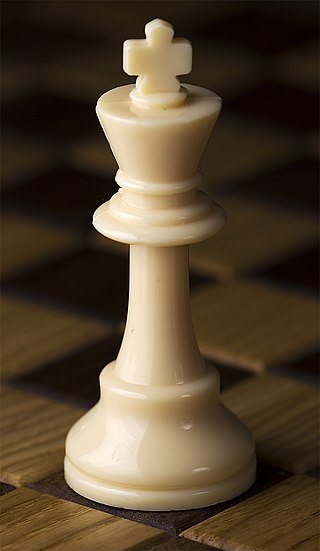Chess strategy is the aspect of chess play concerned with evaluation of chess positions and setting goals and long-term plans for future play. While evaluating a position strategically, a player must take into account such factors as the relative value of the pieces on the board, pawn structure, king safety, position of pieces, and control of key squares and groups of squares. Chess strategy is distinguished from chess tactics, which is the aspect of play concerned with the move-by-move setting up of threats and defenses. Some authors distinguish static strategic imbalances, which tend to persist for many moves, from dynamic imbalances, which are temporary. This distinction affects the immediacy with which a sought-after plan should take effect. Until players reach the skill level of "master", chess tactics tend to ultimately decide the outcomes of games more often than strategy. Many chess coaches thus emphasize the study of tactics as the most efficient way to improve one's results in serious chess play.

The king is the most important piece in the game of chess. It may move to any adjoining square; it may also perform, in tandem with the rook, a special move called castling. If a player's king is threatened with capture, it is said to be in check, and the player must remove the threat of capture immediately. If this cannot be done, the king is said to be in checkmate, resulting in a loss for that player. A player cannot make any move that places their own king in check. Despite this, the king can become a strong offensive piece in the endgame or, rarely, the middlegame.

A chess piece, or chessman, is a game piece that is placed on a chessboard to play the game of chess. It can be either white or black, and it can be one of six types: king, queen, rook, bishop, knight, or pawn.

The knight is a piece in the game of chess, represented by a horse's head and neck. It moves two squares vertically and one square horizontally, or two squares horizontally and one square vertically, jumping over other pieces. Each player starts the game with two knights on the b- and g-files, each located between a rook and a bishop.
A fairy chess piece, variant chess piece, unorthodox chess piece, or heterodox chess piece is a chess piece not used in conventional chess but incorporated into certain chess variants and some chess problems. Compared to conventional pieces, fairy pieces vary mostly in the way they move, but they may also follow special rules for capturing, promotions, etc. Because of the distributed and uncoordinated nature of unorthodox chess development, the same piece can have different names, and different pieces can have the same name in various contexts as it can be noted in the list of fairy chess pieces.
In chess, a relative value is a standard value conventionally assigned to each piece. Piece valuations have no role in the rules of chess but are useful as an aid to assessing a position.
Tamerlane chess is a medieval chess variant. Like modern chess, it is derived from shatranj. It was developed in Central Asia during the reign of Emperor Timur, and its invention is also attributed to him. Because Tamerlane chess is a larger variant of chaturanga, it is also called Shatranj Al-Kabir, as opposed to Shatranj as-saghir. Although the game is similar to modern chess, it is distinctive in that there are varieties of pawn, each of which promotes in its own way.

The empress is a fairy chess piece that can move like a rook or a knight. It cannot jump over other pieces when moving as a rook but may do so when moving as a knight. The piece has acquired many names and is frequently called a chancellor or a marshal.

The princess is a fairy chess piece that can move like a bishop or a knight. It cannot jump over other pieces when moving as a bishop but may do so when moving as a knight. The piece has acquired many names and is frequently called an archbishop or a cardinal; it may also simply be called the bishop+knight compound.

Hexagonal chess is a group of chess variants played on boards composed of hexagon cells. The best known is Gliński's variant, played on a symmetric 91-cell hexagonal board.
Chess with different armies is a chess variant invented by Ralph Betza in 1979. Two sides use different sets of fairy pieces. There are several armies of equal strength to choose from, including the standard FIDE army. In all armies, kings and pawns are the same as in FIDE chess, but the four other pieces are different.
Omega Chess is a commercial chess variant designed and released in 1992 by Daniel MacDonald. The game is played on a 10×10 board with four extra squares, each added diagonally adjacent to the corner squares. The game is laid out like standard chess with the addition of a champion in each corner of the 10×10 board and a wizard in each new added corner square.
The nightrider, alternatively spelled knightrider and also known as the knightmare or unicorn, is a fairy chess piece that can move any number of steps as a knight in the same direction. The nightrider is often represented by an altered version of the knight's icon. In this article, the nightrider is represented by an inverted knight and notated as N; the knight is abbreviated as S for the German name Springer.

The following outline is provided as an overview of and topical guide to chess:

The amazon, also known as the queen+knight compound or the dragon, is a fairy chess piece that can move like a queen or a knight. It may thus be considered the sum of all orthodox chess pieces other than the king and the pawn. The amazon can force checkmate on an enemy king without the help of any other friendly piece.
The wazir or vazir is a fairy chess piece that may move a single square vertically or horizontally. In notation, it is given the symbol W. In this article, the wazir is represented by an inverted rook.
The ferz or fers is a fairy chess piece that may move one square diagonally. It was used in orthodox chess and in Shatranj form of chess before being replaced by the queen.
The camel or long knight is a fairy chess piece with an elongated knight move. It can jump three squares horizontally and one square vertically or three squares vertically and one square horizontally, regardless of intervening pieces. Therefore, it is a (1,3)-leaper.
Chess on a really big board is a large chess variant invented by Ralph Betza around 1996. It is played on a 16×16 chessboard with 16 pieces and 16 pawns per player. Since such a board can be constructed by pushing together four standard 8×8 boards, Betza also gave this variant the alternative names of four-board chess or chess on four boards.
Grant Acedrex is a medieval chess variant dating back to the time of King Alfonso X of Castile. It appears in the Libro de los Juegos of 1283.









